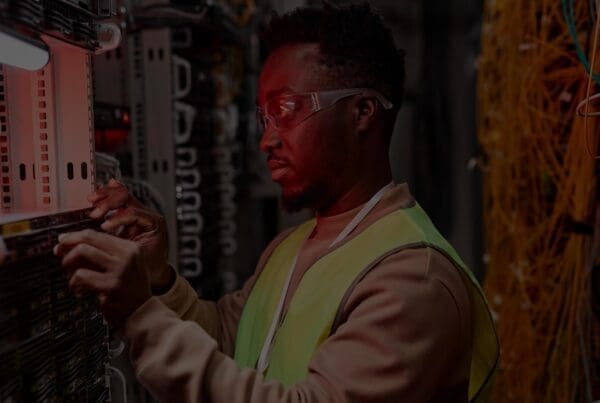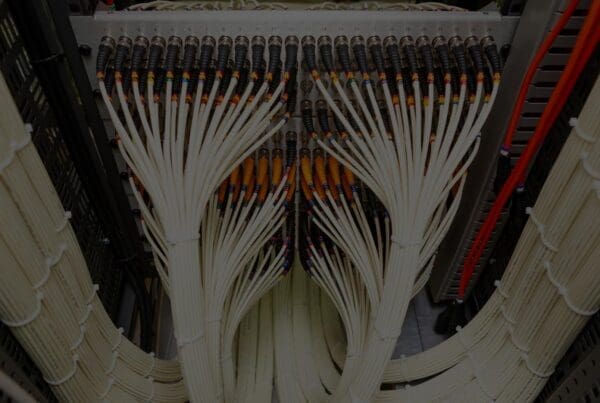In today’s fast-paced digital world, seamless and efficient communication is at the heart of numerous operations across sectors such as business, education, healthcare, and entertainment. A crucial yet often overlooked element that enables this vast and intricate information exchange is structured cabling.
What is Structured Cabling?
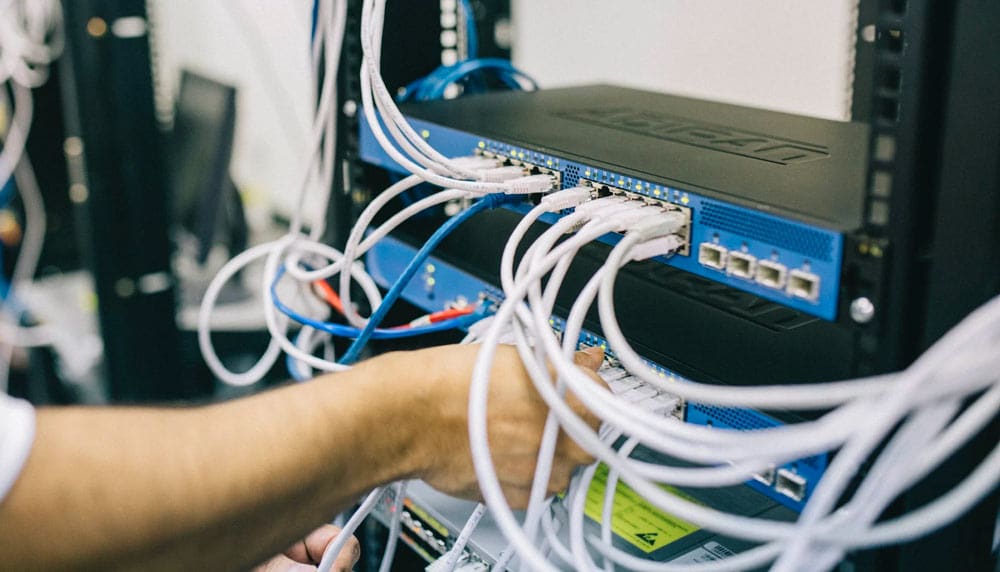
Structured cabling refers to an organised approach to a building’s or campus’s cabling infrastructure. Instead of tackling each new hardware connectivity requirement individually, structured cabling adopts a comprehensive view
It involves designing and installing systems capable of accommodating changes and additions to hardware and connectivity.
The system is designed to transport data, video, and voice signals. It’s organised into six key components:
- Entrance Facilities
- Equipment Room
- Backbone Cabling
- Telecommunications Room
- Horizontal Cabling
- Work Area
The Importance of Structured Cabling in Modern Communication Systems
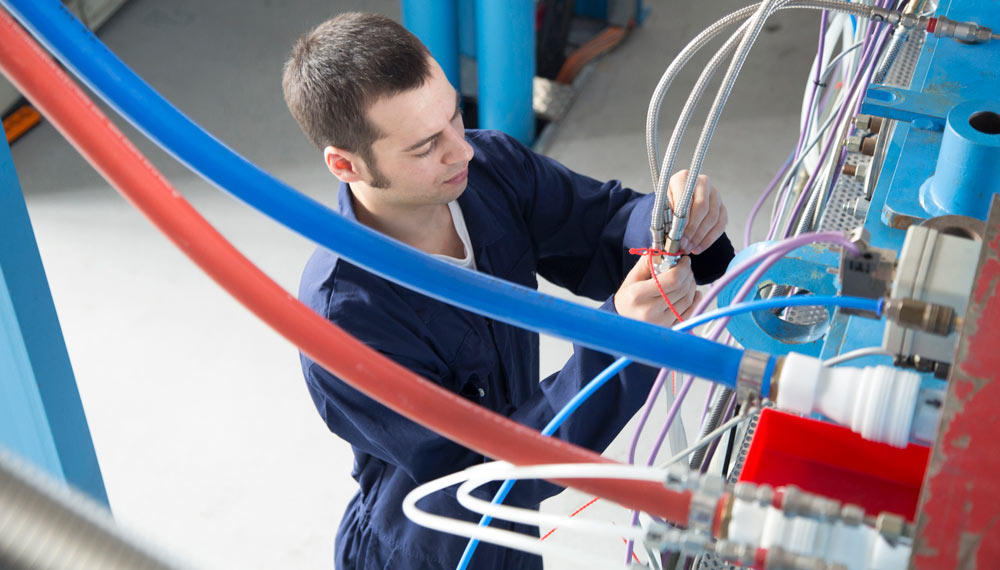
The role of structured cabling in contemporary communication systems is crucial. With data speed and volume demands escalating, a robust, efficient, and adaptable cabling infrastructure becomes imperative.
Key advantages of structured cabling include:
- Adaptability: Structured cabling allows businesses to swiftly adjust to new technologies, augment their network’s speed or capacity, or even relocate with relative ease.
- Risk Reduction: Structured cabling minimises downtime risks associated with human error.
Thanks to its organised and clearly labelled system, changes and troubleshooting can be executed quickly with less potential for mistakes.
What are the 6 Components of Structured Cabling?
Component 1: Entrance Facilities

Entrance Facilities serve as the gateway for both public and private network service cables into a building or campus, and their primary role is to provide a point of interconnection between the outdoor and the internal cabling.
What are Entrance Facilities?
The Entrance Facilities component of a structured cabling system can include various elements:
- Network demarcation point: This marks the boundary where the service provider’s responsibility ends, and the building owner’s responsibility begins. It’s typically the point where the service provider’s cable connects to the premises’ cabling.
- Backbone cabling interfaces: These are the connections that link different buildings in a campus or different floors in a building.
- Telecommunications grounding and bonding infrastructure: This is vital for safety and to prevent damage to equipment from electrical surges.
Role of Entrance Facilities in Structured Cabling
Entrance Facilities play a critical role in the proper functioning of a structured cabling system for several reasons:
- Connection Point: They provide a junction where external service cables meet the internal cabling system, facilitating the transmission of data into and out of the building or campus.
- Protection: With grounding and bonding features, they protect the system and equipment from electrical surges, ensuring the safe operation of the network.
- Flexibility: They allow for easy addition, removal, or modification of connections as per the changing requirements of the network.
Component 2: Equipment Room

The Equipment Room is the centralised area in a structured cabling system where all the building’s or campus’s equipment and hardware are housed. This is essentially the nerve centre of your structured cabling system.
Understanding the Equipment Room
The Equipment Room, also sometimes referred to as the Main Distribution Area (MDA), is a dedicated space within a building or campus that hosts critical networking equipment such as servers, switches, routers, and patch panels. Key elements of an Equipment Room include:
- Racks and Cabinets: These are structures designed to house and organise networking equipment. They help to manage cables and devices efficiently, ensuring easy access for maintenance and upgrades.
- Cable Management Systems: These are tools or accessories that assist in organising and securing cables to prevent tangles and damage. They ensure that cables are easily identifiable and accessible.
- Cooling Systems: Equipment rooms can generate a lot of heat due to the operation of numerous devices. Therefore, efficient cooling systems are necessary to maintain optimal temperature and prevent overheating of equipment.
Role of the Equipment Room in Structured Cabling
The Equipment Room serves multiple crucial functions in a structured cabling system:
- Centralisation: The Equipment Room centralises all networking equipment, making it easier to manage, monitor, and maintain the network. This helps in reducing potential downtime and improving network efficiency.
- Scalability: Having a dedicated room for equipment allows for easier scalability as the network grows. You can add more devices or upgrade existing ones without disrupting the entire network.
- Protection: The Equipment Room provides a secure and controlled environment for valuable networking equipment, protecting them from potential physical harm or environmental hazards.
Component 3: Backbone Cabling
Backbone cabling, also known as vertical cabling or riser cabling, is a critical component of a structured cabling system. It connects the entrance facilities, equipment rooms, and telecommunications rooms in a building or between buildings.
Understanding Backbone Cabling
The term “backbone” cabling is symbolic of its function – much like the backbone in a human body, it provides the main structural support for the entire system. Key elements of backbone cabling include:
- Cables: These are typically high-capacity cables that can handle the aggregate data traffic from various parts of the building or campus. The type of cable used (e.g., copper, fibre optic) depends on the data requirements and distance to be covered.
- Interconnects & Cross-Connects: These are points where different cables connect. Interconnects usually involve a direct connection between two devices, while cross-connects allow for more flexible connections between multiple devices.
- Hardware: This refers to the various components used to support the cabling, such as patch panels, connectors, and switches.
Role of Backbone Cabling in Structured Cabling
Backbone cabling plays several key roles in a structured cabling system:
- Interconnectivity: Backbone cabling serves as the main conduit for data traffic between different areas of a building or between buildings in a campus environment. It ensures that all parts of the network can communicate with each other.
- Scalability: Like the equipment room, backbone cabling also supports network growth. As the data demands increase, you can upgrade the backbone cabling to accommodate higher data rates.
- Redundancy: In many designs, backbone cabling provides redundancy to ensure uninterrupted network performance. If one cable fails, data can be rerouted through other cables to maintain connectivity.
Component 4: Telecommunications Room
The Telecommunications Room (TR) is a vital component of structured cabling, serving as a hub for network connections within a building or campus.
Understanding the Telecommunications Room
The Telecommunications Room, also referred to as the Intermediate Distribution Frame (IDF), is an enclosed space where horizontal cabling from various work areas within a floor or zone is terminated and connected to backbone cabling. Here are some key aspects of the Telecommunications Room:
- Patch Panels and Cross-Connects: The Telecommunications Room houses patch panels, which act as connection points for horizontal cabling from the work areas. Cross-connects facilitate the interconnection between different cables and systems within the room.
- Distribution Racks: These racks are used to organise and manage the equipment and devices in the Telecommunications Room, including switches, routers, and other network infrastructure components.
- Network Equipment: The Telecommunications Room may also house networking equipment necessary for local connectivity, such as switches and power distribution units (PDUs).
- Environmental Controls: Proper ventilation, temperature control, and humidity regulation are crucial in the Telecommunications Room to maintain optimal operating conditions for the network equipment.
Role of the Telecommunications Room in Structured Cabling
The Telecommunications Room plays several key roles in a structured cabling system:
- Connectivity Hub: It serves as a centralised location where horizontal cabling from various work areas is terminated and connected to the backbone cabling, facilitating communication between different parts of the network.
- Ease of Maintenance: The Telecommunications Room provides a convenient and organised space for managing and maintaining network connections. Troubleshooting and making changes or additions become more manageable within this controlled environment.
Scalability: With proper planning, the Telecommunications Room can accommodate future growth and network expansion, allowing for the addition of more work areas and devices.
Component 5: Horizontal Cabling
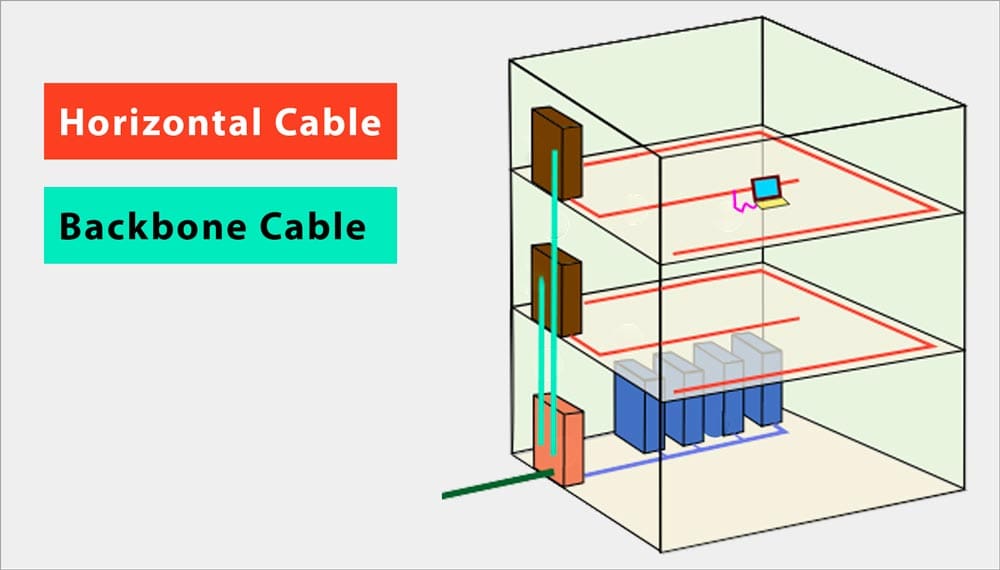
Horizontal cabling is another essential element of structured cabling, connecting workstations, printers, phones, and other devices to the network.
Understanding Horizontal Cabling
The “horizontal” aspect refers to the physical direction of the cabling, typically running horizontally across a floor to connect devices to the closest telecommunications room. Here are some key features of horizontal cabling:
- Cables: In most cases, twisted pair copper cables (like Cat5e, Cat6, or Cat6a) are used for horizontal cabling due to their balance of cost, performance, and ease of installation. However, fibre optic cabling might be used in data-intensive environments or over larger distances.
- Patch Panels: These devices provide a convenient location to manage the connections to various devices. Each port on the patch panel corresponds to a particular workstation or device.
- Work Area Outlets: These are the points where the horizontal cabling terminates at the user end, allowing devices to connect to the network.
Role of Horizontal Cabling in Structured Cabling
Here’s why horizontal cabling is crucial in a structured cabling system:
- Device Connectivity: The primary role of horizontal cabling is to provide network connectivity to individual devices. Without it, workstations, printers, phones, and other devices cannot access the network.
- Flexibility: Horizontal cabling is designed to accommodate changes easily. If a device needs to be moved, added, or removed, the corresponding changes can be made at the patch panel without disrupting the rest of the network.
Performance: Good horizontal cabling practices, such as avoiding electromagnetic interference and not exceeding the maximum cable length, can significantly enhance network performance.
Component 6: Work Area

The work area is where end users interact with the system, connecting their devices to the structured cabling network.
Understanding the Work Area
The work area is the endpoint of the structured cabling system, typically consisting of outlets, patch cables, and devices. Here are its key features:
- Outlets: These are the points where the horizontal cabling terminates. Users plug patch cables into these outlets to connect their devices to the network.
- Patch Cables: These flexible cables connect devices to the work area outlet. They are typically shorter than the horizontal cabling and can be easily moved or replaced as needed.
- Devices: Any device that needs network connectivity, such as a computer, phone, or printer, is considered part of the work area.
Role of the Work Area in Structured Cabling
Here’s why the work area is crucial in a structured cabling system:
- User Access: The work area is where users access the network. Without it, the structured cabling system would be incomplete.
- Flexibility: Because patch cables and devices can be easily added, moved, or removed, the work area allows for a great deal of flexibility. If a user needs to move their desk, for example, they can simply unplug their devices, move, and then plug them back in at the new location.
- Compatibility: The work area is designed to be compatible with a variety of devices, allowing different types of equipment to connect to the same network.
Conclusion
We hope this answers your question: What are the 6 Components of Structured Cabling? With all the components thoroughly explored, it is evident how each component plays a critical role in creating a robust, efficient, and scalable cabling infrastructure. This comprehensive approach to cabling provides organisations with a solid foundation for their communication systems, enabling seamless connectivity and facilitating smooth operations.
Understanding the six components of structured cabling is essential for designing, implementing, and maintaining a reliable and adaptable cabling infrastructure that meets the needs of modern communication systems. By adhering to industry standards and best practices, businesses can ensure optimal performance, flexibility, and scalability in their networks.
How iCobus Can Help

iCobus is here to help you find the right talent that understands and appreciates the significance of structured cabling. We strive to connect businesses with professionals equipped to handle the challenges and opportunities presented by this essential IT component.
So, if you’re ready to solidify your structured cabling capabilities, don’t hesitate to get in touch with us. At iCobus, we’re prepared to guide you through your recruitment journey, ensuring you secure the professionals who can navigate your business through the complex world of structured cabling. Let’s embrace the future of IT together.

